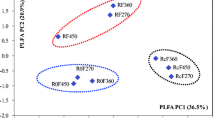Abstract
The data for this paper were derived from a previously reported field trial with Pinus radiata which was treated with fertilizer at planting and three subsequent occasions. The experiment tested factorial combinations of urea (n), dicalcium phosphate (p), gypsum (s) and potassium chloride plus trace elements (b).
At 5 years-of-age bole development was substantially increased by p alone, but p and n in combination increased growth further still. Urea, applied alone, had no, or retardive effects. Foliage concentrations of N, P, K, Ca, Mg, Fe and Mn were raised by p or n and p in combination, but Zn concentrations were not changed. Urea alone caused significantly lower Fe, Mg, Ca, and K concentrations in foliage.
The 16 fertilizer combinations created a series of diverse soil nutrient conditions. For the ameliorative treatments (p and np), soils were characterized by high levels of total P and N, and exchangeable NH +4 and Ca 2+ whereas soils treated with n alone had low levels of the cations Mg2+, Ca2+, and Na+, but higher A13+. While not contributing to stem growth, the s and b treatments also formed unique soil nutrient concentrations; s induced appreciable increases in Ca2+ while b resulted in a 3.5-fold increase in K+.
Multivariate statistical analyses aided examination of the experimental data, whereas univariate analyses became cumbersome or repetitive, or gave no insight into individual contributions to overall variation. Eigenvalues extracted from discriminant analyses did provide this information, and ranked effects in order of importance. The effects of urea fertilizer on concentration of a number of elements in the foliage and on soil nutrient status were small but had marked effects on growth. It is envisaged that multivariate techniques can be utilized with other trial data, provided such experiments are soundly designed and adequately replicated.
Similar content being viewed by others
References
Carlyle, J. C., Turvey, N. D., Hopmans, P. and Downes, G. M. 1989. Stem deformation in Pinus radiata associated with previous land use. Can. J. For. Res. 19:96–105.
Chatfield, C. and A. J. Collins 1979. Introduction to Multivariate Analysis. Chapman and Hall, London, 256 pp.
Comerford, N. B. and Fisher, R. F. 1982. Use of discriminant analysis for classification of fertilizer-responsive sites. Soil Sci. Soc. Amer. J. 46:1093–1096.
Comerford, N. B. and Fisher, R. F. 1984. Using foliar analysis to classify nitrogen-deficient sites. Soil. Sci. Soc. Amer. J. 48:910–913.
Fisher, R A. 1936. The use of multiple measurements in taxonomic problems. Annals Eugenics 7:179–188.
Garten, C. T. 1978. Multivariate perspectives on the ecology of plant mineral element composition. Amer. Natur. 112:533–544.
Green, P. E. 1978. Analyzing Multivariate Data. Dryden Press, Illinois, USA, 519 pp.
Heffernan, B. 1985. A Handbook of Methods of Inorganic Chemical Analysis for Forest Soils, Foliage and Water. CSIRO, Division of Forest Research, Canberra.
Holland, D. A. 1967. The interpretation of the chemical composition of some tropical crops by the method of component analysis. Oleangineaux, 22: 307–310.
Kendall, M. G. 1957. A Course in Multivariate Analysis. Griffiths Statistical Monographs and Courses, No. 2, 185 pp.
Kshirsagar, A. M. 1972. Multivariate Analysis. Marcel Dekker Inc., New York, 534 pp.
Lechowicz, M. J. and Shaver, G. R. 1982. A multivariate approach to the analysis of factorial fertilization experiments in Alaskan Arctic tundra. Ecology 63:1029–1038.
Lee, J., Brooks, R. R., Reeves, R. D. and Boswell, C. R. 1975. Soil factors controlling a New Zealand serpentine flora. Plant soil 42: 153–160.
Mahalanobis, P. C. 1936. On the generalized distance in statistics. Proc. Nat. Inst. Sci., Calcutta 12: 49–50.
Mardia, K. V., Kent, J. T. and Bibby, J. M. 1979. Multivariate Analysis. Academic Press, London, 521 pp.
Raupach, M., Clarke, A. R. P. and Cellier, K. M. 1978. Disorder symptoms of a forest of Pinus radiata in relation to foliar nutrient levels. Aust. For. Res. 8:1–11.
SAS Institute Inc. 1985. SAS Users Guide: Statistics, 5th edition. Cary, N.C. SAS Institute, 956 pp.
Seal, H. 1964. Multivariate Statistical Analysis for Biologists. Methune and Co. Ltd, London, 209 pp.
Snowdon, P. and Waring, H. D. 1985. Effects of factorial combinations of urea, dicalcium phosphate, gypsum, and potassium chloride on growth and foliage composition of closely spaced Pinus radiata. Aust. For. Res. 15: 333–352.
Turvey, N. D., Rudra, A. B. and Turner, J. 1986. Characteristics of soil and productivity of Pinus radiata (D. Don) in New South Wales. 1. Relative importance of physical and chemical parameters. Aust. J. Soil Res. 24: 95–102.
Van Laar, A. 1987. Multivariate analysis: a way to better understanding of complexity. S. Afr. For. J. 141:33–41.
Waring, H. D. 1969. The role of nitrogen in the maintenance of productivity in conifer plantations. Commonw. For. Rev. 48:226–237.
White, E. H. and Mead, D. J. 1971. Discriminant analysis in tree nutrition research. For. Sci. 17:425–427.
Willson, K. C. and Freeman, G. H. 1970. Use of principal component analysis on data from chemical analysis of tea leaves. Exp. Agric. 6:319–325.
Author information
Authors and Affiliations
Rights and permissions
About this article
Cite this article
Woollons, R.C., Snowdon, P. Utility of multivariate analyses in examining foliage composition and soil nutrition in a factorial fertilizer experiment. New Forest 5, 289–305 (1991). https://doi.org/10.1007/BF00118858
Received:
Accepted:
Issue Date:
DOI: https://doi.org/10.1007/BF00118858




